Business
One of America’s reddest states wants 100% green energy — if dams count as green
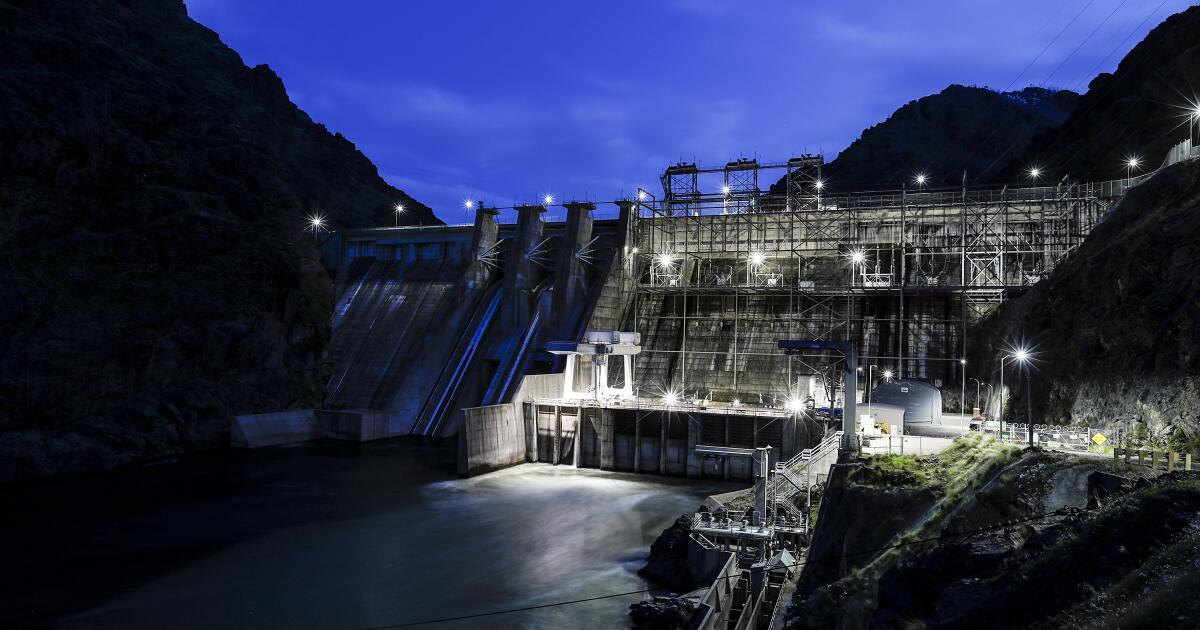
Deep in the bowels of Idaho’s Brownlee Dam, Neal Lincoln is ready to offer a demonstration.
Almost 40 feet below the surface of the Snake River — whose waters originate in Yellowstone National Park, then cascade down the Rocky Mountains and course across Idaho — Lincoln makes a call to the power plant control room. The narrow hallway where we stand waiting is chilly, the air dank and the floor covered with leakage from the river.
A siren goes off. A minute later there’s a long whooshing sound from behind an imposing metal hatch, as the control room fires up the hydroelectric turbine on the other side — the largest hydro turbine operated by Idaho’s largest power company.
Neal Lincoln, operator of Brownlee Dam for Idaho Power, stands at the end of a hallway beneath the flow of the Snake River.
(Robert Gauthier / Los Angeles Times)
I grab hold of a handle on the hatch, my fingers brushing a “DANGER” warning sticker, and feel a powerful vibration as water rushes through the turbine. As the blades turn, they spin a generator up above, sending electricity onto the power grid. Below, the water exits through a large tube, emerging from the bottom of the dam and into the river more than 50 feet beneath us.
Here in the narrow hallway, it’s getting louder and louder, the walls rattling and rumbling. There are no fossil fuels being burned, no coal or oil or natural gas heating the planet and filling the air with pollution. Just hydropower, which forms the backbone of the Gem State’s electric grid and has allowed Idaho Power to pledge 100% clean energy by 2045.
It’s an unprecedented green ambition in a deep-red state — or a greenwashing sham, depending on whom you ask.
Energy reporter Sammy Roth and a team of visual journalists spent a week in Idaho trying to find out: Are hydropower dams a valuable source of climate-friendly energy? Or a fish-killing monstrosity that should be torn down? (Video by Jessica Q. Chen and Maggie Beidelman / Los Angeles Times)
Brownlee is one of 17 hydroelectric dams owned by Idaho Power on the Snake River and its tributaries. These artificial river-stoppers, and others operated by the federal government, have devastated salmon and steelhead trout populations, blocking many of their historical spawning grounds and depriving Indigenous tribes of fish central to their nourishment and cultures.
Those harms, and others, aren’t unique to Idaho.
Across the American West, dams have reshaped ecosystems for the worse, raising water temperatures, diminishing downstream flows and driving fish species toward extinction. From Grand Coulee Dam on the Columbia River to Hoover Dam on the Colorado, reservoirs have fueled toxic algae blooms, increased evaporation and flooded land that was home to Native Americans for millennia.
As far as some tribal and environmental activists are concerned, many of those dams never should have been built.
Maybe they should even be dismantled.

The flow of the Snake River has been fundamentally altered by Hells Canyon Dam.
(Robert Gauthier / Los Angeles Times)
Nobody has proposed tearing down Idaho Power’s hydroelectric plants — at least not yet. But one of the nation’s highest-profile battles over dam removal is playing out downstream in Washington, near the Snake River’s confluence with the Columbia.
It’s a battle that has scrambled traditional political alliances, with U.S. Rep. Mike Simpson, an Idaho Republican, leading the push to remove four dams on the Lower Snake, and prominent Democrats, including Washington Gov. Jay Inslee, urging caution.
“Idaho salmon runs are going extinct,” Simpson said at a conference in Boise this year. “We can’t let that happen.”
Almost everybody wants to protect salmon. Here’s the challenge.
Even if every Western dam stays in place, we’ll need to build a mind-boggling number of solar fields, wind turbines, lithium-ion batteries and long-distance electric lines to break our fossil fuel addiction — and fast. That’s going to be tough, even after the landmark climate bill signed by President Biden last year. Already, opposition to renewable power infrastructure is bubbling up from rural communities, conservationists and tribes as ever-larger stretches of land are eyed by energy developers.
Start tearing down dams, and the energy transformation gets even harder. In a typical year, hydropower plants generate around 6% or 7% of U.S. electricity. The lower that number gets, the more sprawling solar and wind farms we’ll need to build.
And as much damage as dams cause, other types of climate-friendly power generation aren’t totally clean either.
Solar fields can chew up desert wildlife habitat. Wind turbine blades can kill endangered birds. Mines to supply lithium for electric car batteries and energy storage devices can decimate ecosystems and raze landscapes held sacred by Native Americans.
There are no perfect climate change solutions. But the increasingly deadly heat waves, hurricanes, wildfires and droughts caused by fossil fuel combustion don’t care about that. They’ll only get worse if we make the perfect the enemy of the good.
All of which brings us back to Brownlee Dam.
Another siren goes off, and the hallway quiets down as water stops flowing. We walk upstairs to see the hydroelectric generator, which was added to the dam’s four original generators in 1978 and can produce as much as 265 megawatts — enough to supply roughly 200,000 homes at full blast. Lincoln estimates his brief demonstration produced about 10 megawatts.
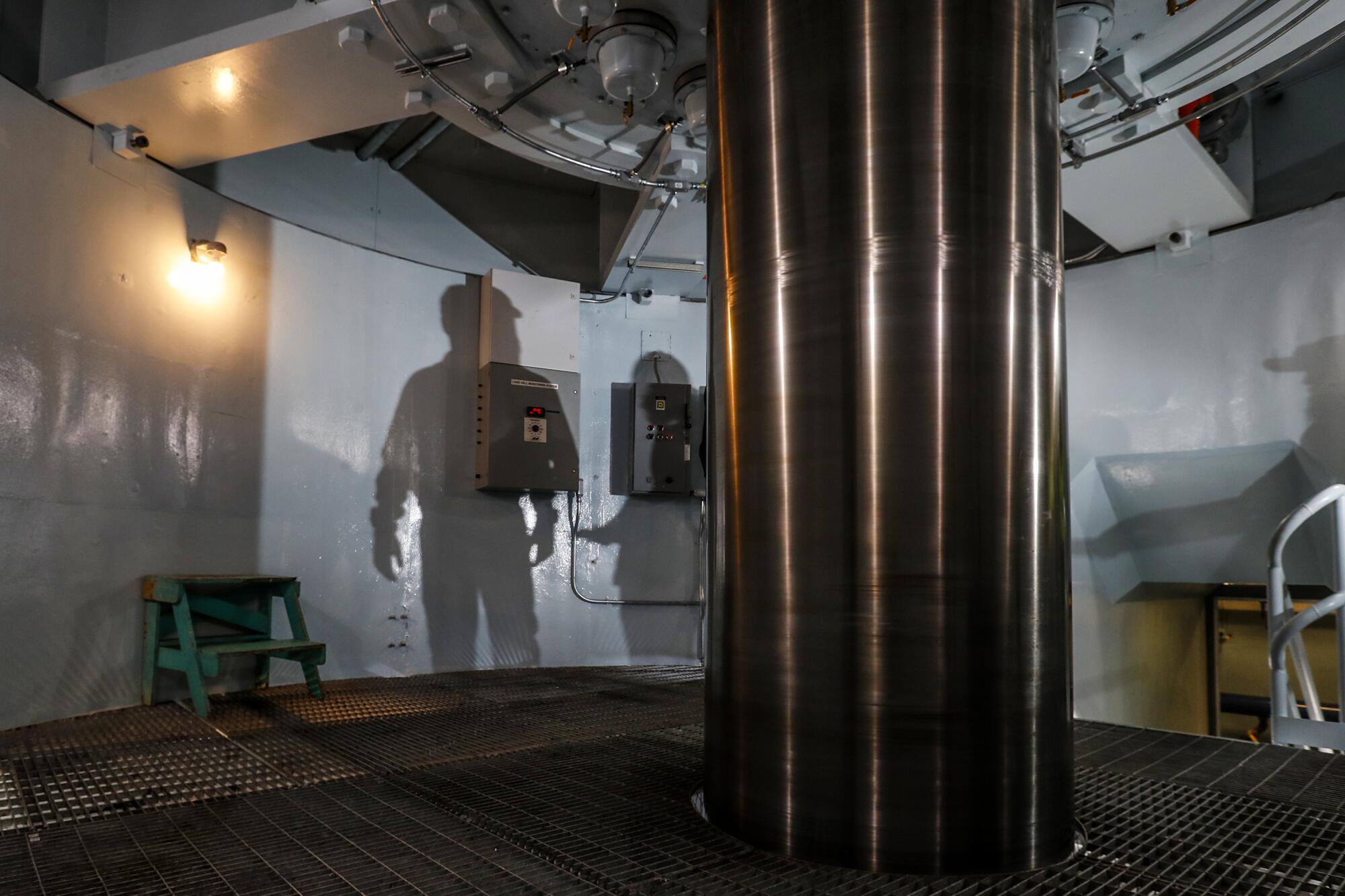
One of five shafts connecting hydropower turbines to generators within Brownlee Dam.
(Robert Gauthier / Los Angeles Times)
That power is a lot better than coal and oil and gas. But is it worth sacrificing a healthy river to help preserve a safe planet?
A team of Los Angeles Times journalists spent a week in Idaho trying to answer that question. We sat down with Idaho Power’s president, walked along the Snake with an agent of local tribes and watched the sun rise over a spectacular river canyon with environmental activists. We also explored alternatives to hydropower, including a controversial plan for the Gem State’s biggest wind farm.
Are hydroelectric dams good or bad for the planet and the people living on it?
Here’s what we saw, and what it means for the West.

Up against the wall
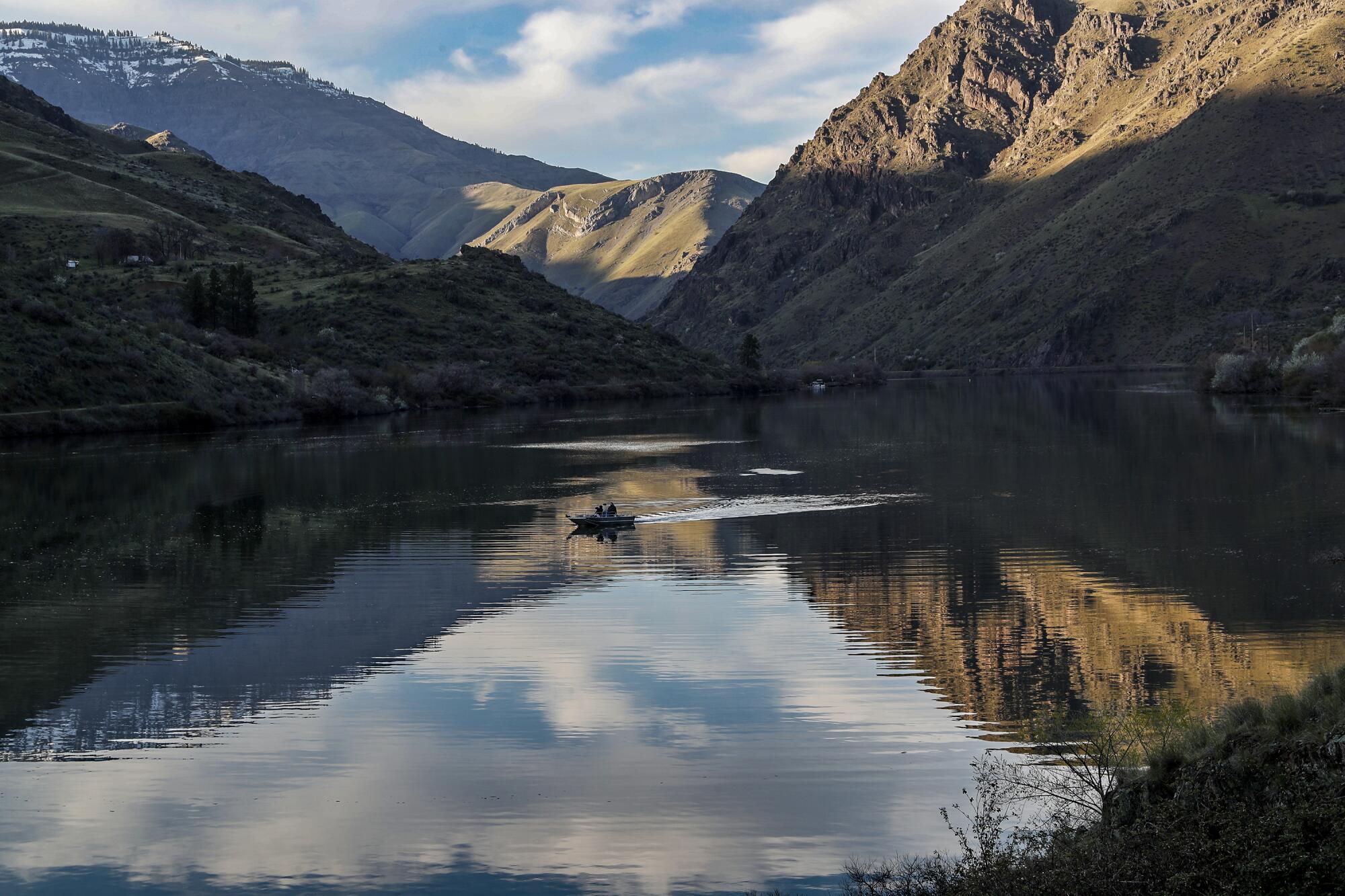
An unnaturally placid section of the Snake River, between Oxbow Dam and Hells Canyon Dam.
(Robert Gauthier / Los Angeles Times)
Brownlee Reservoir is low this spring morning. A boat dock is totally dry, its end not quite reaching the water. A thin bathtub ring lines the bottom of the hills on the far side, as Idaho Power leaves room for mountain snowmelt after a wet winter.
Scott Hauser’s wife likes to water ski with friends on Brownlee over the summer. But Hauser can’t bring himself to join them. After a decade-plus working for the Upper Snake River Tribes Foundation, he sees this artificial lake as “the death knell for tribes.”
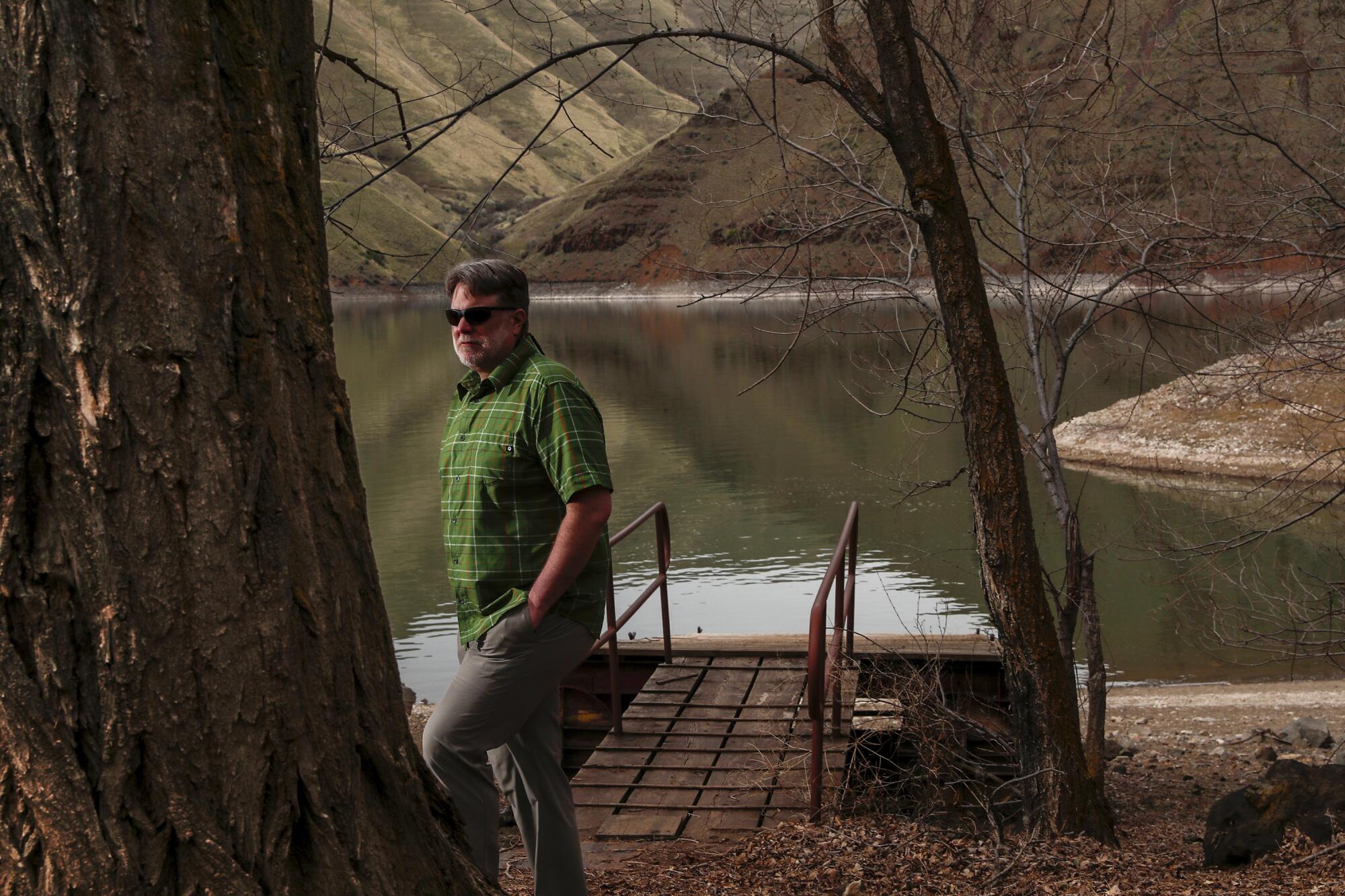
Scott Hauser, executive director of Upper Snake River Tribes Foundation, at Idaho Power’s Brownlee Reservoir on the Snake River.
(Robert Gauthier / Los Angeles Times)
“I didn’t even want to come here today,” he says, his voice cracking with emotion as we stand by the reservoir’s edge.
Hauser isn’t Native American. But as the foundation’s executive director, and its environmental program director before that, he’s gotten so invested in the struggle for justice that it’s hard for him to visit this wildly altered stretch of the Snake River.
The Snake is one of many tributaries of the Columbia River, which collectively drain a quarter-million square miles — an area larger than France. The watershed covers most of Idaho, much of Oregon and Washington and parts of Nevada, Utah, Wyoming and British Columbia. It connects Missoula, Mont., with Portland, Ore., funneling their rain and snow to the Pacific Ocean.
For millions of years, salmon and steelhead built their lives around that water, being swept out to the ocean as youngsters and then, a few years later, swimming back upstream to their home streams to spawn. Indigenous tribes such as the Nez Perce and the Shoshone-Bannock subsisted on those fish, with salmon in particular taking on great spiritual significance.
Then white settlers arrived, re-engineering the Columbia and its tributaries to suit their own needs. They built dozens of dams that remain in place today, generating electricity, storing irrigation water for farms and protecting cities from floods.
On the Snake, none of those dams is taller than Brownlee, part of a three-dam complex with Oxbow and Hells Canyon.
As many as 1.7 million chinook salmon and steelhead once returned from the Pacific each year to spawn upstream of where Hells Canyon now interrupts the Snake. Idaho Power says that number had dropped to 25,000 by the time its dams were built.
Whatever your starting point, today a concrete wall serves as an insurmountable barrier.
“This was the most productive fall chinook spawning area in the world,” Hauser says. “And now we’ve gone to zero fish.”
Pre-Western colonization, he tells me, the tribes he works for ate as much as two pounds of salmon per person per day. Today members of the Shoshone-Bannock Tribes of the Fort Hall Reservation eat just half a pound of salmon per person — per year.
“There’s thousands of salmon just slamming their heads against the downstream side of Hells Canyon Dam,” Hauser says.

Dead steelhead that were spawned at a hatchery near Oxbow Dam.
(Robert Gauthier / Los Angeles Times)
In addition to blocking the Snake, the three dams trap irrigation from farms and dairies, leading to fertilizer chemical buildups that can cause low oxygen levels, harmful algae blooms and dangerous amounts of mercury, a neurotoxin. Health officials warn against eating too many fish from Brownlee Reservoir and have occasionally urged people not to touch the water at all.
High temperatures are another issue. Water stored in reservoirs absorbs sunlight, resulting in warmer flows downstream that make it even harder for fish to survive. Climate change adds to the overall ecosystem stress, heating the river and fueling longer dry spells and more intense wet spells.
And even as hydropower turbines help fight the climate crisis by generating pollution-free electricity — especially when they start up after sundown, limiting the need for gas-fired power plants — the reservoirs behind them can release substantial amounts of methane, a powerful heat-trapping gas, as plants and other organic materials buried beneath the water decompose.
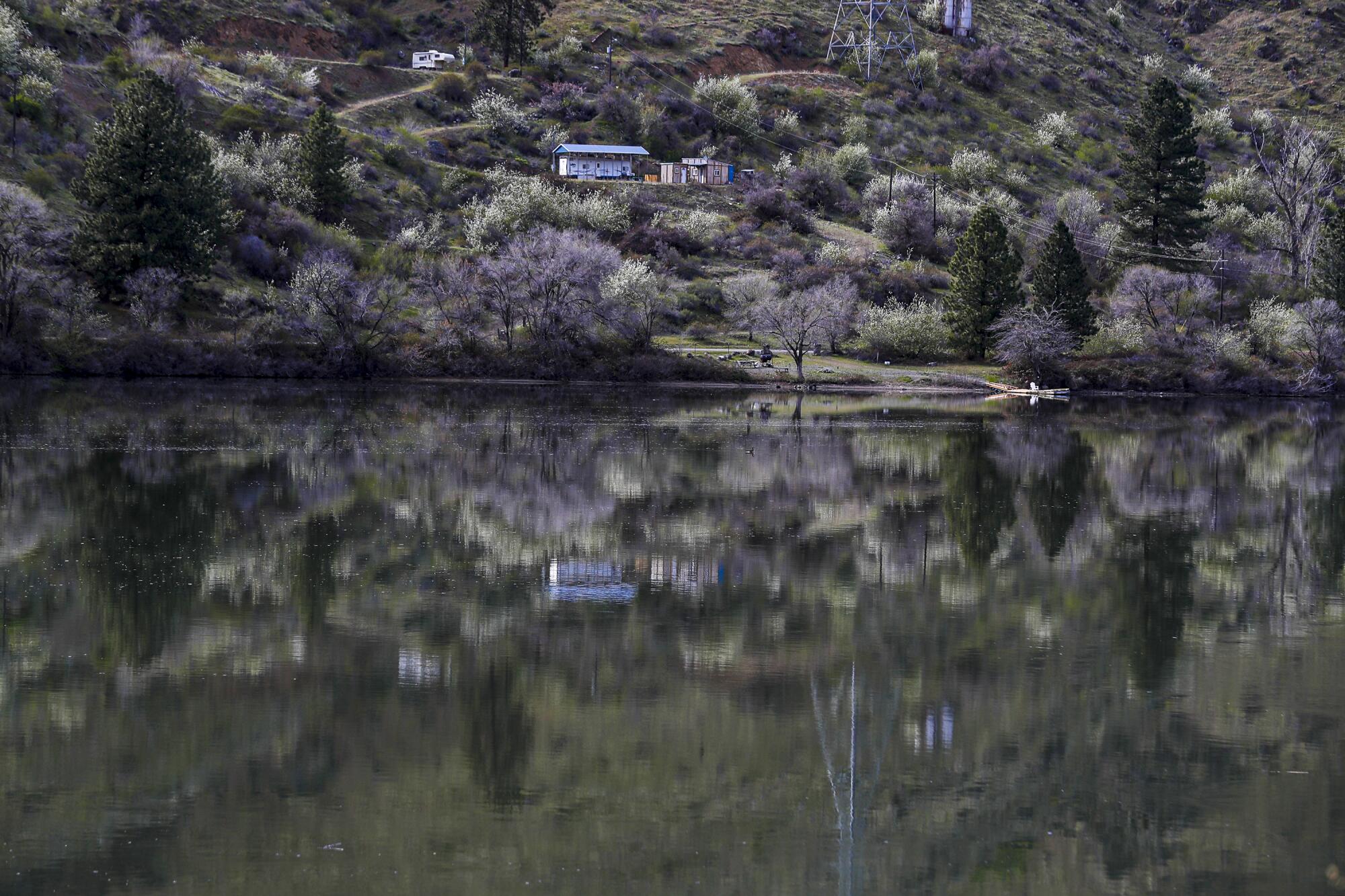
The Snake River flows near the town of Oxbow, which was built by Idaho Power.
(Robert Gauthier / Los Angeles Times)
Hydroelectric dams are, on the whole, still a lot better for the atmosphere than fossil fuels. But they’re no saint.
“The concept that hydropower is clean power is really a fallacy,” Hauser says.
For many environmentalists, the question is which dams should come down, and which ones we still need.
In the Columbia River Basin, much of the attention has focused on four dams downstream of Hells Canyon, on a 100-mile stretch of the Lower Snake running across southern Washington. Operated by the U.S. Army Corps of Engineers, these dams are the ones that Simpson, the Republican member of Congress, wants so badly to tear down, as do the Nez Perce and other tribes.
The battle has dragged on for years, with most Republican officials looking to protect the dams and leading Democrats arguing they should come down only after the benefits they provide — including energy, irrigation and transportation for wheat grown by Washington farmers — are replaced. Simpson has proposed a $33.5-billion plan to breach and replace the dams.
Aggressive and impactful reporting on climate change, the environment, health and science.
The debate frustrates Hauser, who says there’s never been serious talk about dismantling the Hells Canyon dams so harmful to the tribes he represents. But he’s been hesitant to push for them to come down, worried that doing so could prompt a backlash that jeopardizes support for removing the four dams on the Lower Snake.
Although politicians and conservationists tend to think about the two sets of dams separately, Hauser’s employers have taught him they’re connected. Tribes, he said, “don’t think about these little boxes. They think about the whole ecosystem.”
Breach the Lower Snake dams, he asks, and what happens to all the fish that will just end up blocked by Hells Canyon?
That’s a question for Idaho Power.
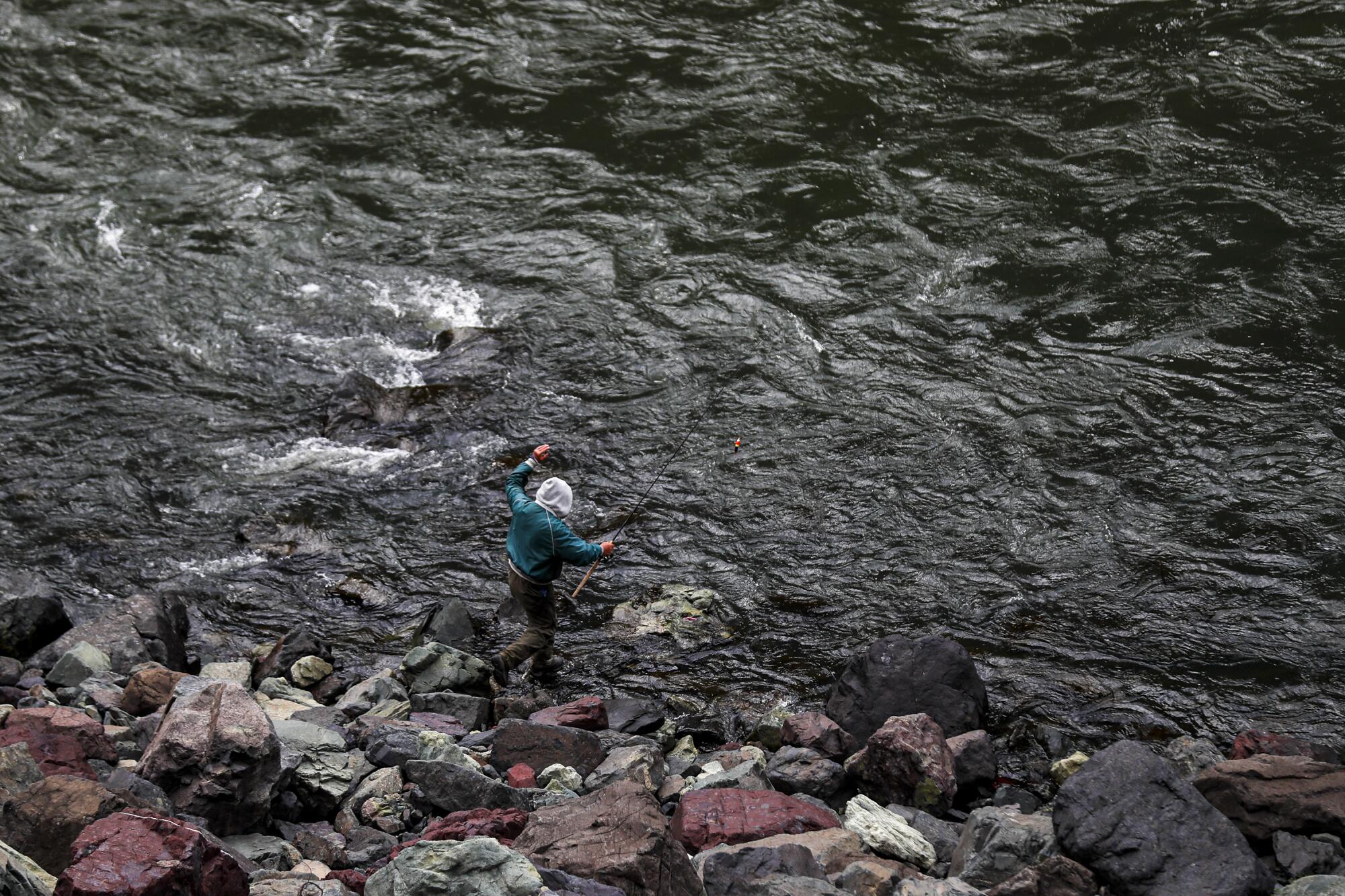
A person fishes on the rocky shoreline of the Snake River near Hells Canyon Dam.
(Robert Gauthier / Los Angeles Times)
The clean and the dirty
Idaho is one of the nation’s most conservative states. Nearly two-thirds of voters chose Donald Trump for president in 2020.
So it was startling when Idaho’s largest utility announced in 2019, halfway through the Trump administration, that it would target 100% clean energy. Deep-blue California had adopted such a mandate just six months earlier, and there was no movement in the Idaho Legislature to do the same. Yet Idaho Power was one of the first U.S. utilities to commit to zero carbon pollution.
What prompted that decision?
Lisa Grow, the company’s chief executive, has a simple answer: People were asking for it.

Idaho Power’s chief executive, Lisa Grow, at the utility’s headquarters in downtown Boise.
(Robert Gauthier / Los Angeles Times)
In Boise, city officials were gearing up to announce a 100% clean energy goal. Companies such as Facebook and semiconductor maker Micron Technology were looking for renewable energy to power their data centers and factories.
An Idaho Power survey found that 90% of its customers would support 100% clean energy, so long as their bills didn’t go up.
“We’re not doing it because we want to be like California,” Grow tells me. “We think it’s the right thing for Idaho.”
She and her team decided they could get to 100%. But not without hydro.
Even with rivers choked by drought last year, Idaho Power’s dams supplied nearly one-third of its electricity. Add in wind, solar and other zero-carbon resources, and in a wet year the company’s supplies can be 70% climate-friendly.
So how is the utility dealing with the destruction wrought by its dams?
That’s my main question the next day, when we set out before sunrise from a tiny company town nestled along the Snake, where the river separates Idaho from Oregon. We’re joined by Brett Dumas, Idaho Power’s director of environmental affairs.
He’s wearing a Patagonia jacket — ironic, he acknowledges, given the retailer’s opposition to dams.
His boss Grow “always gives you kind of the stink eye when you wear Patagonia,” Dumas says.

Brett Dumas, director of environmental affairs for Idaho Power, at Hells Canyon Dam on the Snake River.
(Robert Gauthier / Los Angeles Times)
We park atop Hells Canyon Dam. Dark clouds loom overhead, the water below glistening in the early-morning light as it carves a path between the brown rocks of Oregon’s Wallowa Mountains and Idaho’s Seven Devils Mountains. Two of the dam’s hydropower turbines are running; workers are preparing to replace the third later this afternoon, nearly 60 years after it first started up.
Few of the local fish protected under the Endangered Species Act, which include several species of salmon and steelhead, make it as far upstream as Hells Canyon to spawn, considering the many federal dams between here and the Pacific Ocean.
But all of those downstream dams have “fish ladders” that make it possible for at least some returning fish to swim past them.
So why don’t Hells Canyon, Brownlee and Oxbow?
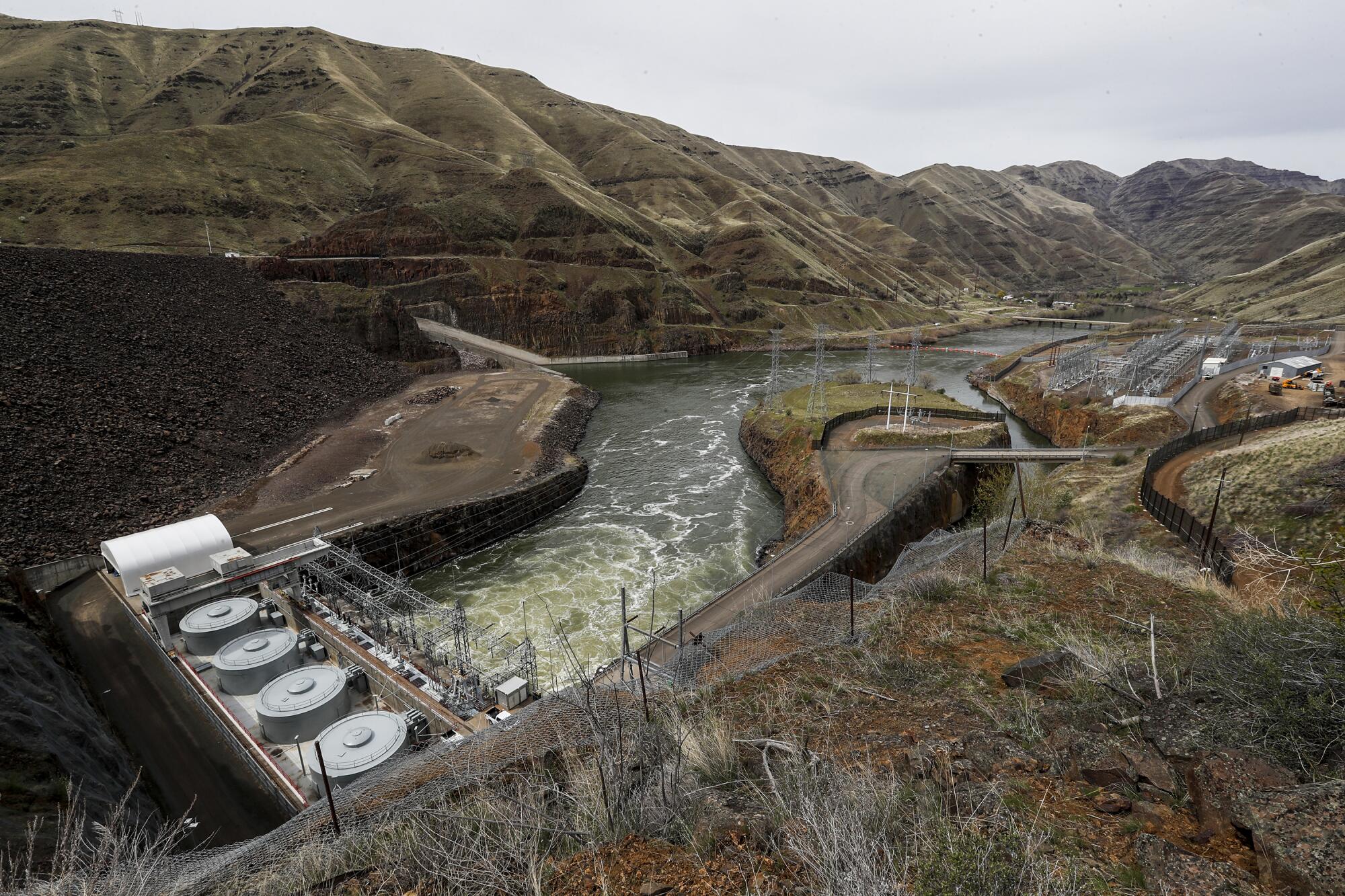
The Snake River flows through hydropower turbines at Brownlee Dam.
(Robert Gauthier / Los Angeles Times)
Decades ago, Idaho Power spent a few years trapping salmon and hauling them upstream past Brownlee, which was built before Hells Canyon. That worked just fine. The problem came when the company tried to help young salmon go the other way, setting up a net to catch them behind Brownlee and move them to the downstream side, so they could swim to the Pacific. The juveniles had trouble reaching the net, getting lost in the reservoir’s slack waters without a strong current to pull them.
So Idaho Power gave up on that program, with federal officials instead ordering the utility to build a series of hatcheries.
“Today we produce just under 7 million juvenile steelhead and salmon each year,” Dumas says.
We tour a hatchery later that day. It’s run by Idaho Department of Fish and Game staff, who take steelhead captured behind Hells Canyon Dam and combine their eggs and sperm. Employees have produced about 1 million eggs over the last few weeks.
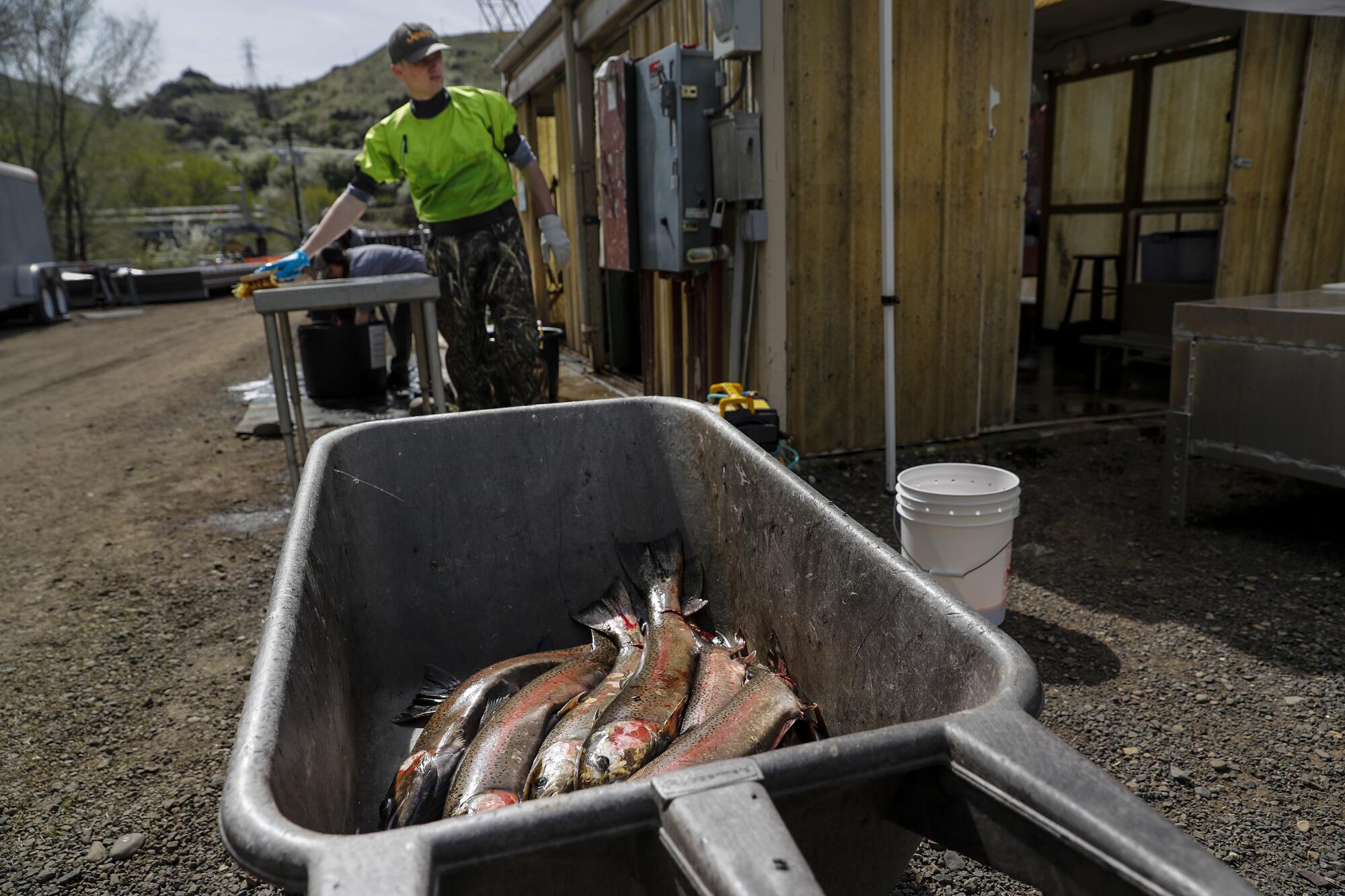
The steelhead hatchery near Oxbow Dam is currently undergoing renovations.
(Robert Gauthier / Los Angeles Times)
We head to the incubation building, where a staffer pulls out a shallow tray full of eggs. I lean in for a closer look at hundreds of tiny red spheres that remind me of “Finding Nemo.” Nearly all of them have faint gray dots: embryonic fish eyes.
But as valuable as the hatcheries are, they don’t make up for all the harm done by Idaho Power’s dams. Far from it.
Under long-standing requirements, the fish produced at these hatcheries are sent to Idaho, Oregon and the Nez Perce Tribe, with none set aside specifically for the Upper Snake River tribes that Hauser represents. What’s more, hatchery fish are genetically less resilient than wild fish — in a world where resilience is increasingly important, with climate change heating rivers and oceans.
Add in water pollution from farms and other human intrusions, and it’s no wonder salmon continue to struggle.
“It’s not the same as a natural river,” Dumas says. “We all know that.”
Idaho Power has taken other steps to improve conditions on the Snake, funding mercury research at Brownlee and launching a pilot program that pays farmers to convert from flood irrigation to sprinklers, reducing polluted runoff. As part of a long-running federal relicensing process for the Hells Canyon dam complex, which appears to be nearing its conclusion, the utility has agreed to spend $1 billion on environmental measures over the next 50 years, including efforts to reduce river temperatures.

A person fishes from a dock on the Snake River, between Oxbow and Hells Canyon dams.
(Robert Gauthier / Los Angeles Times)
At the behest of Oregon regulators, Idaho Power also plans to reintroduce salmon and steelhead in Oregon’s Pine Creek, which flows into the Snake near Oxbow. Federal regulators have suggested they could go further, by ordering the company to truck fish around Hells Canyon and reintroduce them in Idaho waterways, despite a state law designed to block such a move.
None of those steps will return the river to what it once was.
But in a warming world, neither would tearing down the dams.

Nothing is easy
Two hundred miles southeast of Hells Canyon, cows are mooing and birds are chirping as the sun rises over the Snake River Plain. A power line cuts across fields of sagebrush and invasive plants, the snow-capped Sawtooth Range rising to the north.
Luke Papez and his employer hope to build hundreds of wind turbines across this vast stretch of mostly public lands.
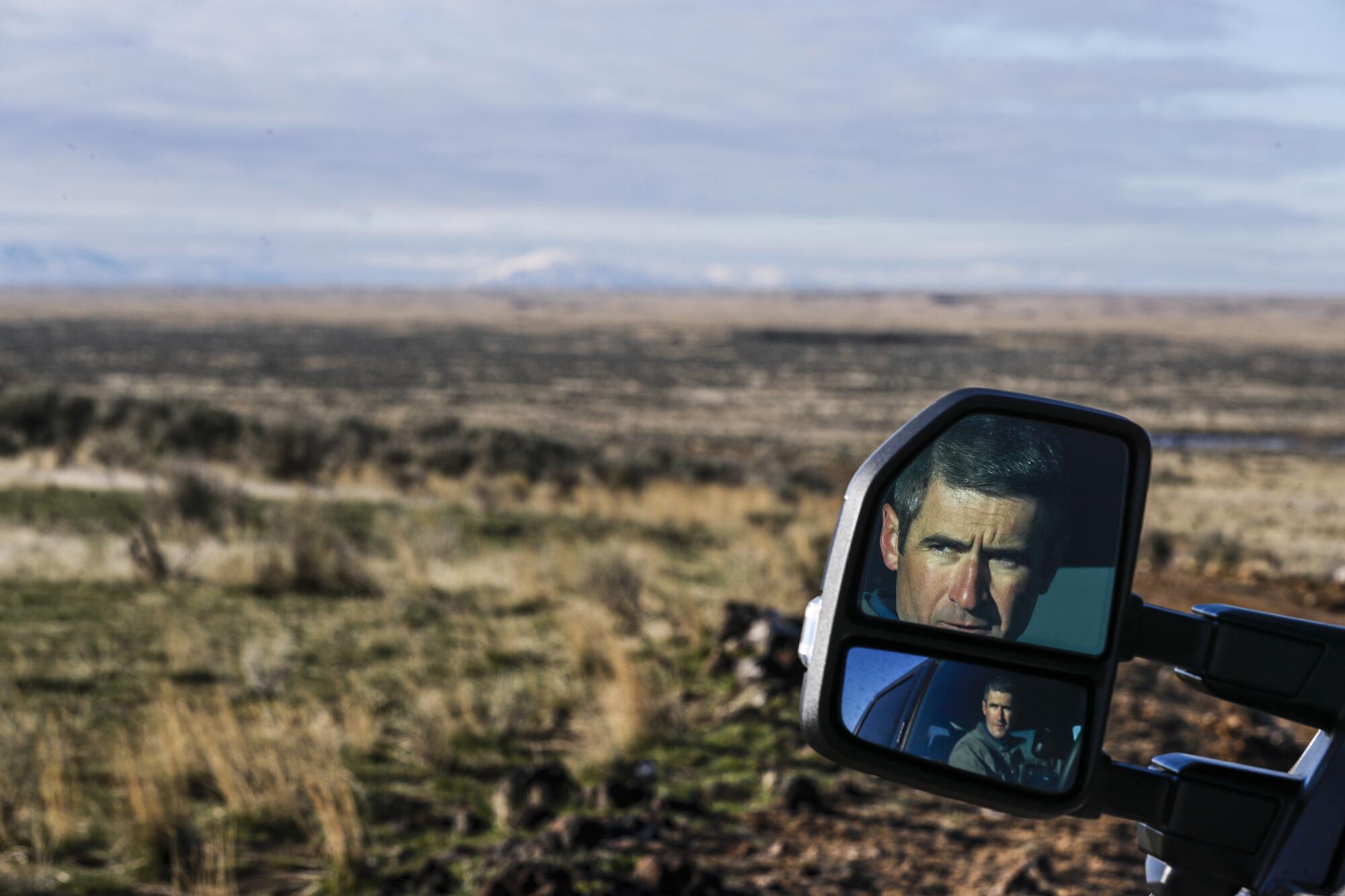
Luke Papez, LS Power’s project manager for the proposed Lava Ridge wind farm, drives across the project site.
(Robert Gauthier / Los Angeles Times)
But they’re facing opposition from an unlikely source: Friends of Minidoka, a nonprofit dedicated to preserving the memory of the Japanese American prison camp operated by the federal government a few miles from here during World War II.
The group says Idaho’s largest wind farm would be a blight on the landscape, with massive turbines cluttering the desolate views and making it hard to imagine the feelings of isolation experienced by more than 13,000 people incarcerated at Minidoka.
“I’m going to have an opinion,” Papez says. “But it’s not going to be the same as your opinion, and it’s not going to be the same as a Japanese American’s opinion…. There’s some amount of science to it, and there’s some amount of subjectivity to it.”
This dispute is just one of many involving renewable energy projects across the West.
But it’s a valuable case study for why tearing down dams would make stopping climate change even harder.
LS Power, Papez’s employer, started looking for windy spots in Idaho several years ago. The New York company thought it had found a good place for a wind farm, but government officials encouraged it to look elsewhere, saying the desired site was valuable habitat for greater sage grouse — a troubled bird species known for its elaborate mating dance.
The developer later set aside a second site for the same reason.
“At that point we crumpled up the wind map and threw it out the window,” Papez says.
That’s how the company ended up in a farming and ranching area on the Snake River Plain. It’s seeking a federal permit for its Lava Ridge wind farm, with the Bureau of Land Management publishing a draft environmental analysis in January.
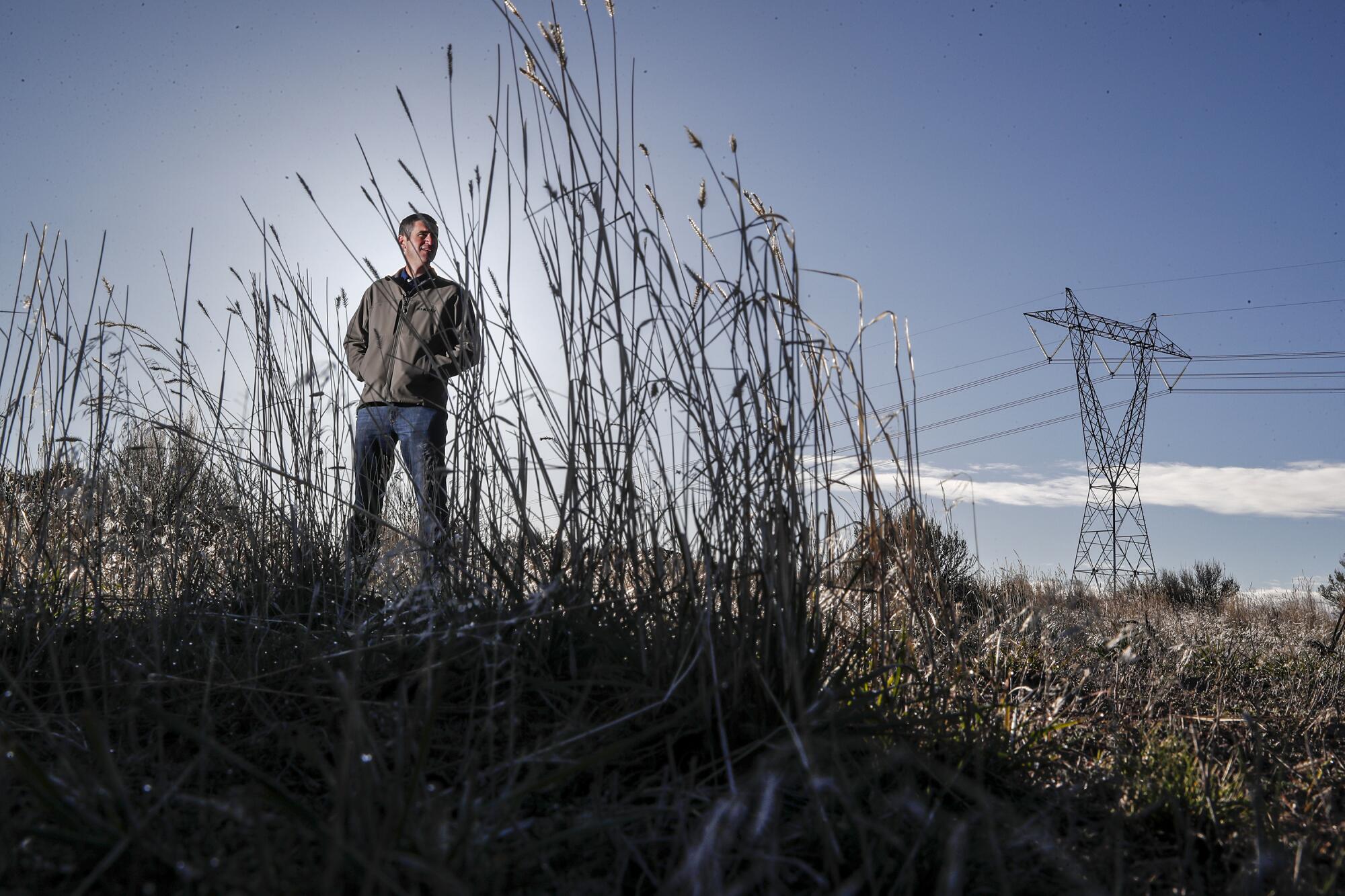
LS Power’s Luke Papez stands near electric lines on the Lava Ridge site.
(Robert Gauthier / Los Angeles Times)
We hike up a rocky hill, the loud winds making conversation tough. Papez manages to point out a few landmarks, including a spot where LS Power was forced to propose a three-mile buffer around an unexpectedly active sage grouse breeding ground.
I ask Papez if he ever gets frustrated. Doesn’t he wish he could just get permission to start building wind turbines?
“That would be easy,” he says. “But I think the things that are worth doing in life often aren’t that easy to do.”
Sometimes for good reason.
After bidding adieu to Papez, we head to Minidoka National Historic Site. It’s not hard to grasp the trauma experienced here.
“This land has a lot to tell,” says Robyn Achilles, Friends of Minidoka’s executive director.
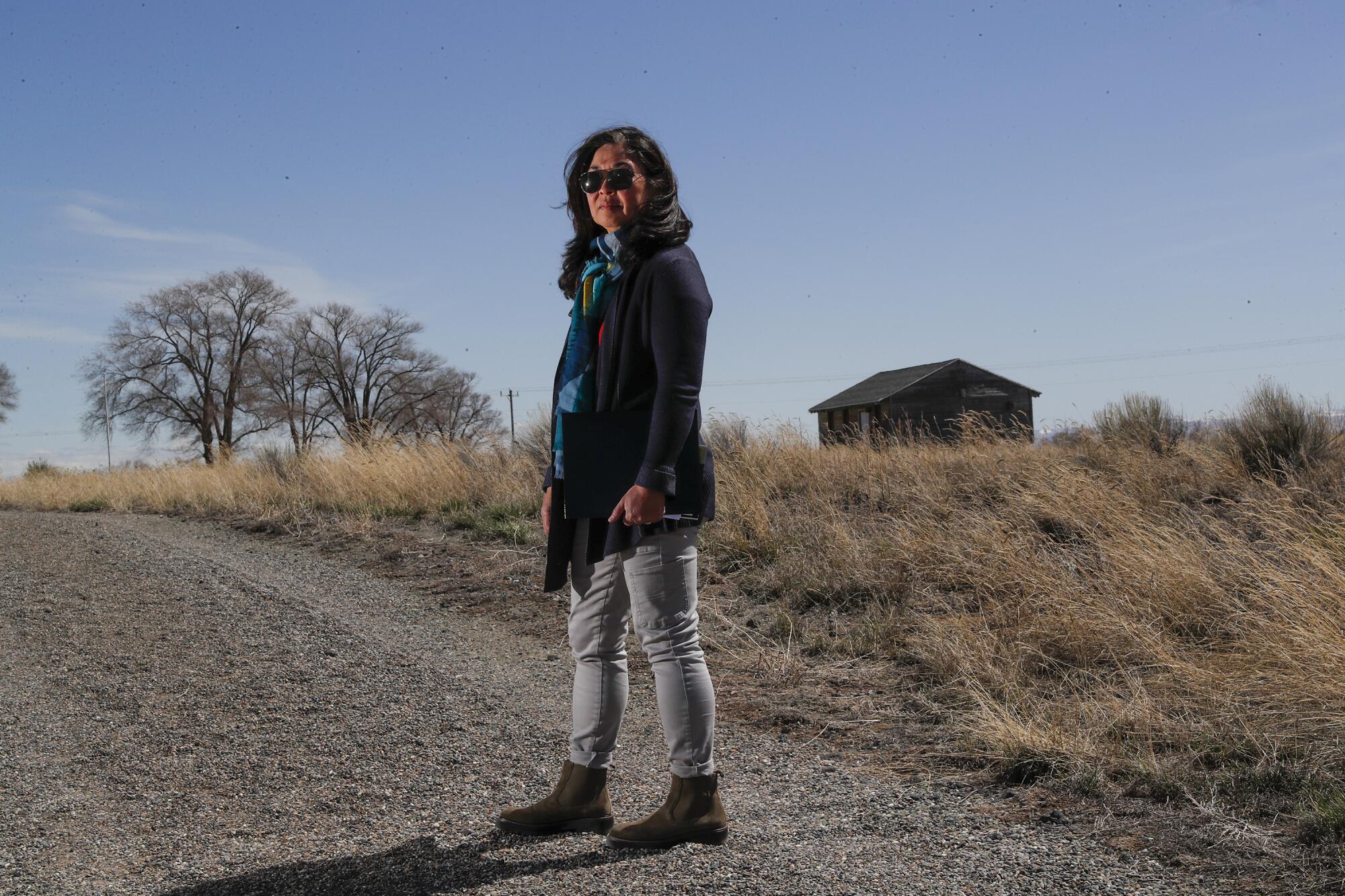
Robyn Achilles, executive director of Friends of Minidoka, at Minidoka National Historic Site.
(Robert Gauthier / Los Angeles Times)
As we walk across the quiet grounds — past historic barracks, a restored baseball field and an “honor roll” listing more than 800 incarcerees who went on to serve in the U.S. military, many voluntarily — Achilles and her colleagues have stories to share. About families torn from their homes and livelihoods, often never to return. About communal showers and toilets that eliminated any sense of privacy. About parents who refused for decades to talk with their children about their suffering.
I’m deeply moved by the stories. Still, I can’t help but wonder: Would wind turbines on the horizon really diminish this place? Visual simulations prepared as part of the federal review process suggest the machines wouldn’t fundamentally change the viewshed.
Achilles has given this a lot of thought. For Japanese Americans, she says, Minidoka is “hallowed ground.” When descendants of former incarcerees visit, she tells me, many break out in tears as they see what life was like for their parents or grandparents.
Part of what they learn is just how remote the prison was. Even if incarcerated people made it past the barbed-wire fences, “the prison was the landscape, because there was no place for them to go,” Achilles says.
“Would you put wind turbines over the memorial for Flight 93? Or over the Washington Monument?” she asks.
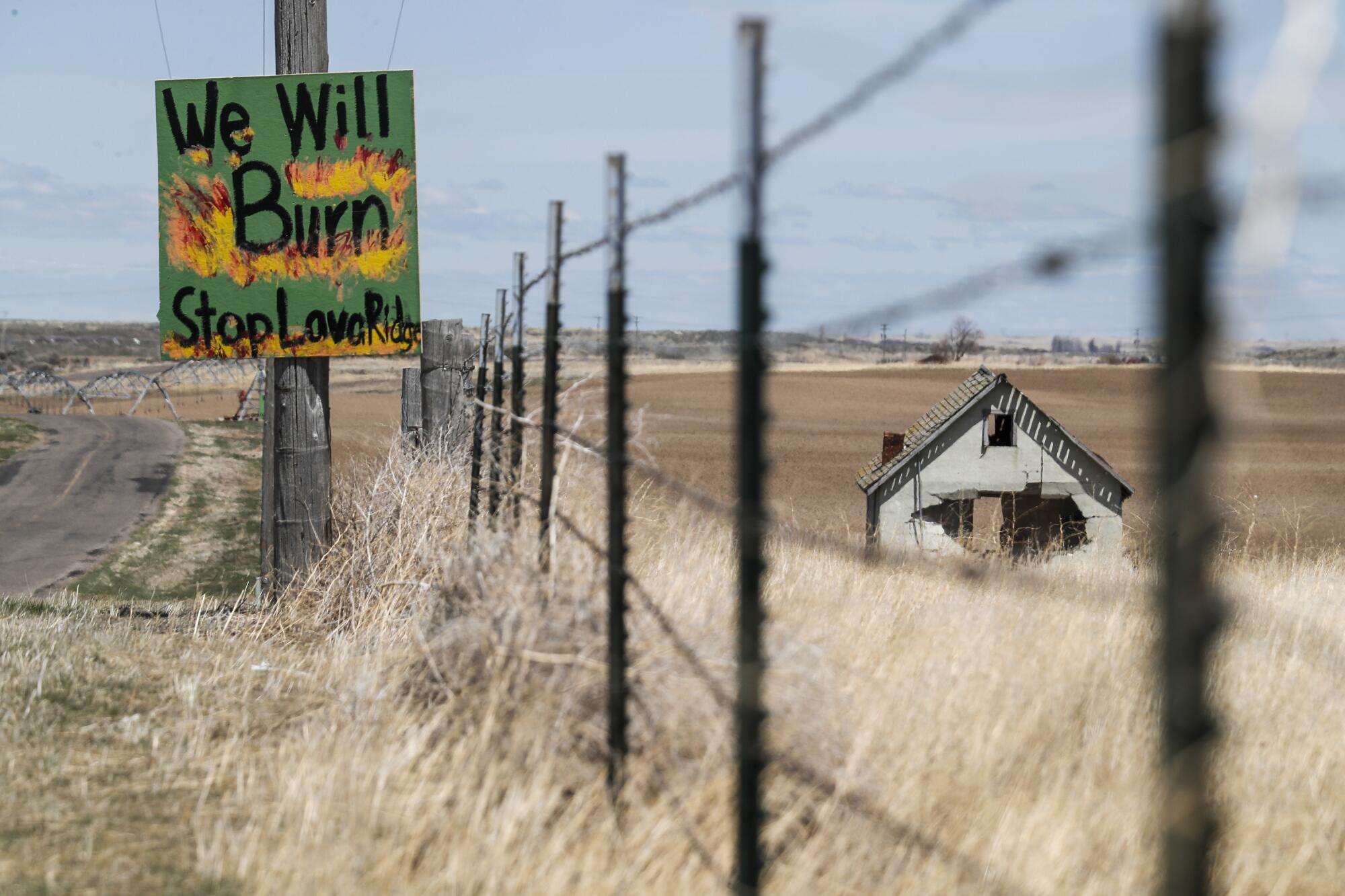
A sign opposing the Lava Ridge wind farm is posted along the road to Minidoka National Historic Site.
(Robert Gauthier / Los Angeles Times)
LS Power says it’s willing to build a smaller wind farm, farther from Minidoka.
The company’s initial plan included turbines as close as two miles to the historic site. But Papez and his team are open to other configurations. Under one of the “preferred alternatives” studied by the Biden administration, federal officials could require LS Power to build turbines no closer than 8.5 miles to Minidoka, shrinking the project from 400 turbines to 269.
Would that be good enough?
Definitely not, Achilles says. The landscape is so flat, she tells me, that turbines could be seen dozens of miles away.
“If the project is built, it would absolutely change people’s experience at the site,” she says.
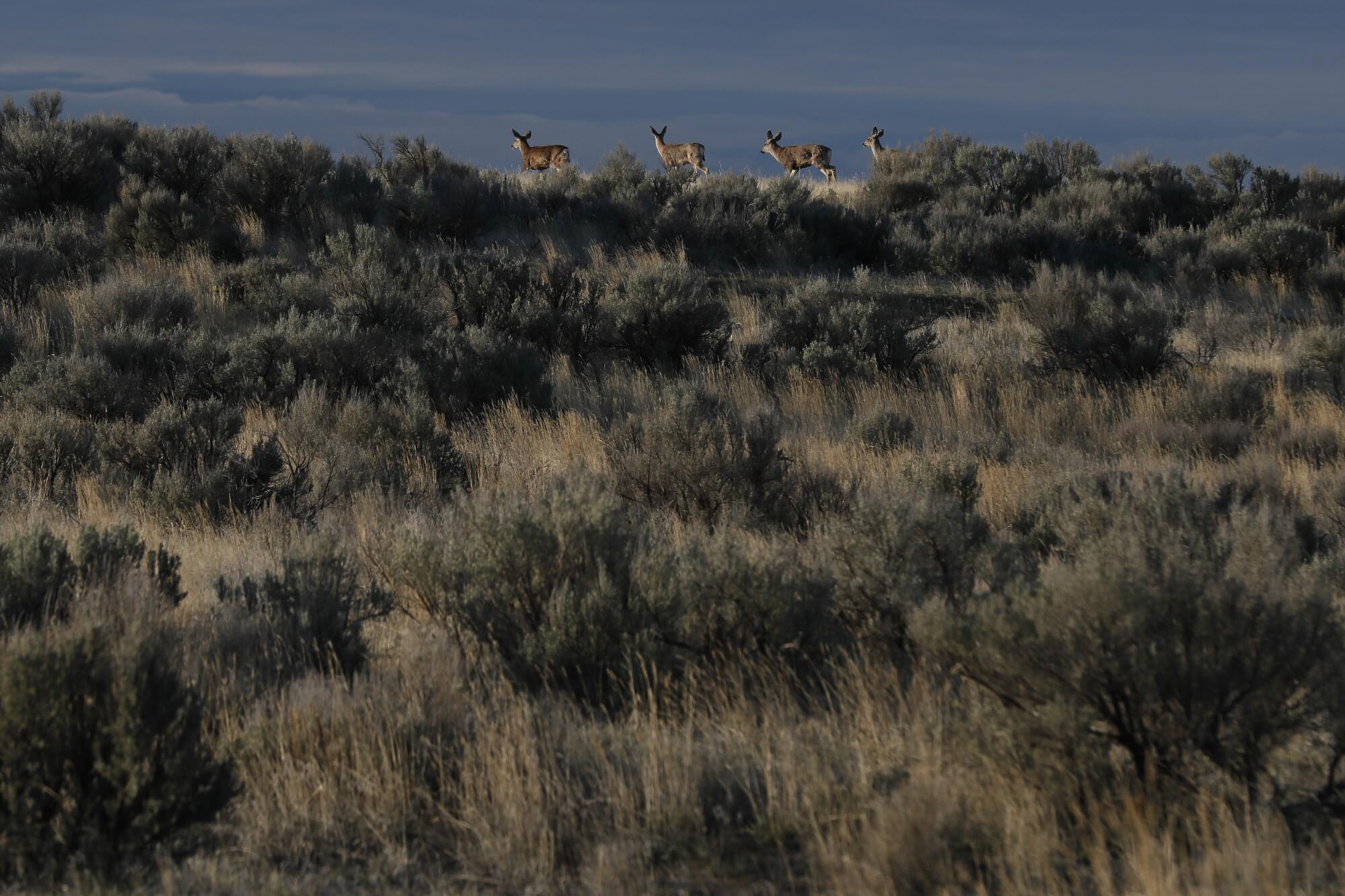
Deer roam across the site of the proposed Lava Ridge wind farm.
(Robert Gauthier / Los Angeles Times)
Whatever your own view might be, keep this in mind: Every renewable energy project faces some form of local opposition. If we want to avoid the worst consequences of the climate crisis, many of those facilities will need to get built regardless.
And the more that get blocked? Then the more hydropower we’ll need.

Getting to yes
We stand transfixed on the rim of a verdant canyon, the Snake River meandering past 400 feet below as the sun comes up over Dedication Point. The low-lying clouds and distant horizon cycle through a series of rich blues and soft yellows, the changing light bathing the canyon walls in magnificent golden hues. Prairie falcons that nest in those walls soar through the air.
Down by the water’s shimmering edge, we spot a group of campers.
“The West may seem wide open. But when you get down to it, every single patch of ground has a stakeholder that’s very invested in it,” says John Robison, a staffer at the Idaho Conservation League. “There are no more real empty spaces in the West.”
This canyon is a prime example.

An April sunrise over Dedication Point on the Snake River.
(Robert Gauthier / Los Angeles Times)
A few years back, federal officials were considering letting Idaho Power and another utility build a power line near Dedication Point, which is part of the Morley Nelson Snake River Birds of Prey National Conservation Area, a raptor sanctuary. But after seeking input from the Idaho Conservation League and others, who worried the line would disrupt some of the area’s best remaining sage grouse habitat, land managers and the utilities agreed on a compromise route that avoids the worst environmental damage.
“Everybody had to come to the table,” Robison says. “It took several years to work it out.”
That kind of compromise is crucial to building the huge amounts of infrastructure we’ll need to avoid climate catastrophe.
So what can clean energy developers and government agencies do to address the concerns so often raised by conservationists, rural towns and Native American tribes? How can we make sure we have enough solar and wind farms — and, yes, hydropower dams — churning out carbon-free electricity to avoid a future where we’ll all wish we had made different choices?
Justin Hayes doesn’t have all the answers. But he has some ideas.

Justin Hayes, executive director of the Idaho Conservation League, at Dedication Point overlooking the Snake River.
(Robert Gauthier / Los Angeles Times)
As executive director of the Idaho Conservation League, Hayes has spent a lot of time trying to “get to yes” on badly needed clean energy projects, to use his words. That’s meant pressing LS Power, for instance, to do more to limit potential harm to sage grouse and migrating pronghorn at Lava Ridge — a wind farm that Hayes doesn’t yet support but hopes to eventually.
“We need to figure out a way to get projects like that on the ground,” he says.
To Hayes, that will require federal land managers giving the public more ways to weigh in on clean energy projects without outright objecting to their approval. It will also require ensuring that communities on the front lines of the energy transition, including rural towns and Indigenous tribes, receive tangible benefits when projects are built in their backyards.
“People want to be heard,” Hayes says. “We have to listen and try.”
As we leave Dedication Point and drive down into the canyon, we get a look at Swan Falls Dam, site of the first hydroelectric plant built on the Snake in 1901. An American flag flutters over the small power plant, 200 miles upstream of Hells Canyon.
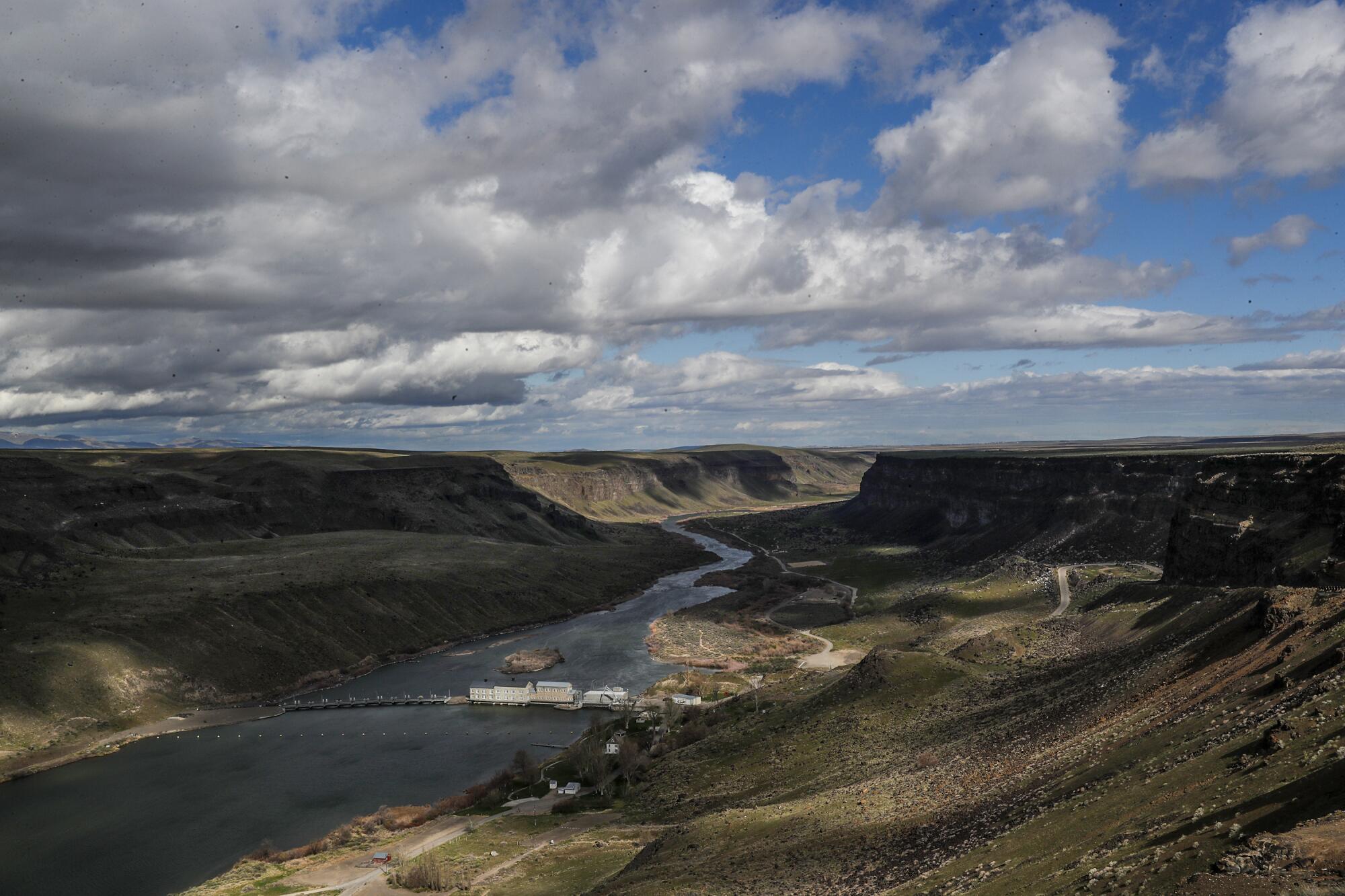
Swan Falls Dam on the Snake River.
(Robert Gauthier / Los Angeles Times)
We park on a dirt road that runs alongside the river. Robison pulls out his binoculars and looks for birds while Hayes and I evaluate the pros and cons of hydropower. Dams have long been a major force driving salmon species toward extinction — but now they can help salmon too, by producing carbon-free electricity that limits the effects of climate change.
Hydropower from the Pacific Northwest has been especially valuable for California, helping the state keep the lights on after dark. At the same time, global warming is making dams a less reliable energy source by sapping the flow of Western rivers.
Some conservationists have advocated for tearing down the worst dams while adding hydroelectric capacity at others. Groups including American Rivers, the Nature Conservancy and the World Wildlife Fund have spent several years working toward that end, partnering with the National Hydropower Assn. to seek tens of billions of dollars in federal funding.
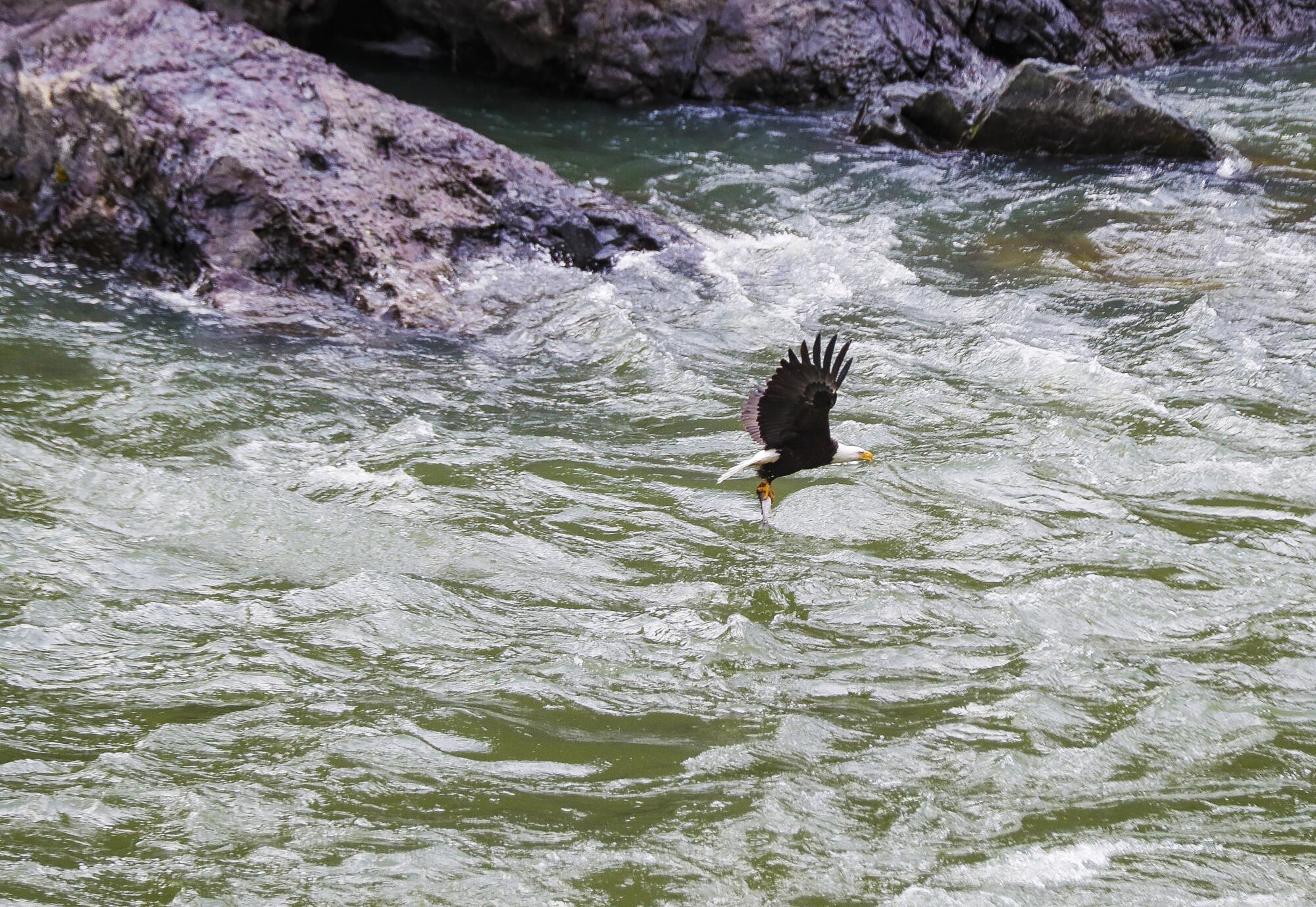
A bald eagle makes off with a fish in its talons as it soars through Hells Canyon on the Snake River.
(Robert Gauthier / Los Angeles Times)
Hayes has a similar view. He agrees with Simpson, Idaho’s Republican member of Congress, that the best way to help salmon and steelhead would be to tear down the four dams on the Lower Snake. Not much electric capacity would be lost, in Hayes’ view, and fish would have easier access to the Salmon River, a free-flowing Snake River tributary and a great place to spawn.
“Those dams are not clean energy if they are resulting in the extinction of species and cultures,” Hayes says.
And what about Idaho Power’s Hells Canyon dams? Should those come down too?
“I don’t think the region is ready to go there,” Hayes says. “I don’t think we are able to go there as a society at this point.”
Because of climate change?
“Because of climate change,” he says. “Because of our needs. Because of the way that the system is built.”
I’ve spent the week asking questions about Idaho. But the answers are relevant to the broader American West. We’re all part of the same electric grid, the same century-old machine with dozens of interlocking pieces that will either lift each other up or drag each other down as society moves on from fossil fuels. The more climate-friendly power on the Western grid, the easier it will be for all of us — red state or blue — to keep our air conditioners running without fossil fuels during the next heat wave.
And the more fish sentenced to death to make that possible?
You won’t find a simple answer along the banks of the Snake River. Only gently flowing water, meted out by a dam.
Support our journalism
Your support helps us deliver the news that matters most. Subscribe to the Los Angeles Times.
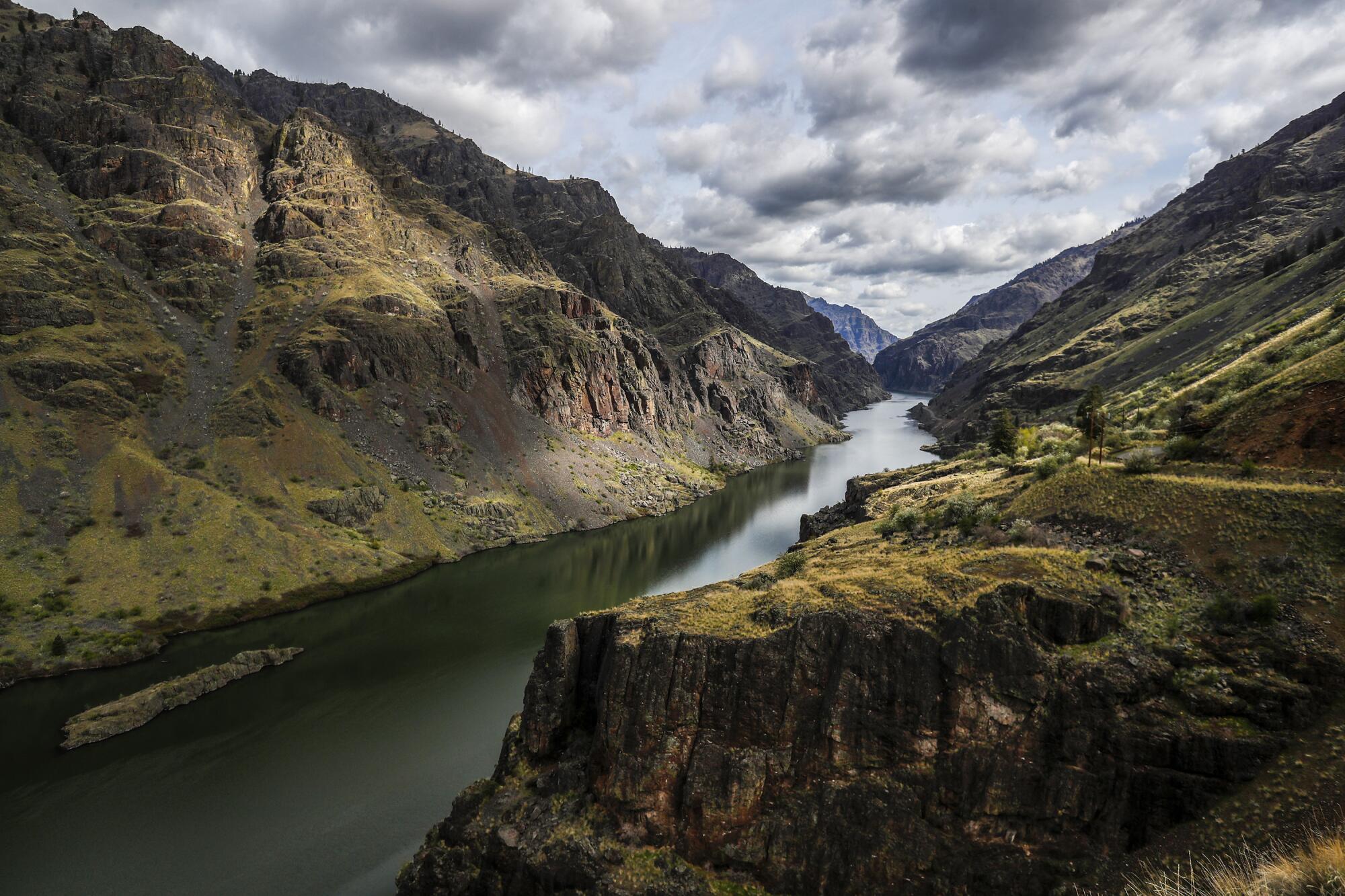
The Snake River flows toward Hells Canyon Dam.
(Robert Gauthier / Los Angeles Times)

Business
How Hard It Is to Make Trade Deals

President Trump has announced wave after wave of tariffs since taking office in January, part of a sweeping effort that he has argued would secure better trade terms with other countries. “It’s called negotiation,” he recently said.
In April, administration officials vowed to sign trade deals with as many as 90 countries in 90 days. The ambitious target came after Mr. Trump announced, and then rolled back a portion of, steep tariffs that in some cases meant import taxes cost more than the wholesale price of a good itself.
The 90-day goal, however, is a tenth of the time it usually takes to reach a trade deal, according to a New York Times analysis of major agreements with the United States currently in effect, raising questions about how realistic the administration’s target may be. It typically takes 917 days, or roughly two and a half years, for a trade deal to go from initial talks to the president’s desk for signature, the analysis shows.
Roughly 60 days into the current process, Mr. Trump has so far announced only one deal: a pact with Britain, which is not one of America’s biggest trading partners.
He has also suggested that negotiations with China have been rocky. “I like President XI of China, always have, and always will, but he is VERY TOUGH, AND EXTREMELY HARD TO MAKE A DEAL WITH!!!” Mr. Trump wrote on Truth Social on Wednesday. China and the United States agreed last month to temporarily slash tariffs on each other’s imports in a gesture of good will to continue talks.
Part of what the president can accomplish boils down to what you can call a deal.
The pact with Britain is less of a deal than it is a framework for talking about a deal, said Wendy Cutler, the vice president of the Asia Society Policy Institute and a former U.S. trade negotiator. What was officially released by the two nations more closely resembled talking points for “what you were going to negotiate versus the actual commitment,” she said.
During his first term, Mr. Trump secured two major trade agreements, both signed in January 2020. One was the United States-Mexico-Canada Agreement, which was a reworking of the North American free trade treaty from the 1990s that had helped transform the economies of the three nations.
U.S.M.C.A. is an all-encompassing, legally binding agreement that resulted from a lengthy and formal process, according to trade analysts.
Such deals are supposed to cover all aspects of trade between the respective nations and are negotiated under specific guidelines for congressional consultation. Closing the deal involves both negotiation and ratification — modifying or making laws in each partner country. The deals are signed by trade negotiators before the president signs the legislation that puts it into effect for the United States.
Mr. Trump’s other major agreement in his first term was with China, in an echo of the current trade war. The pact, unlike previous deals, came about after Mr. Trump threatened tariffs on certain Chinese imports. This “tariff first, talk later” approach, said Inu Manak, a trade policy fellow at the Council on Foreign Relations, is part of the same playbook the administration is currently using.
The result was a nonbinding agreement between the two countries, known as “Phase One,” that did not require approval from Congress and that could be ended by either party at any time. Still, it took almost one year and nine months to complete. China ultimately fell far short of the commitments it made to purchase American goods under the agreement.
A comparison of the two first-term Trump deals shows the drawn-out and sometimes winding paths each took to completion. Fragile truces (including ones made for 90 days) were formed, only for talks to break down later, all while rounds of tariffs injected uncertainty into the diplomatic relations between countries.
The Times analysis used the date from the start of negotiations to the date when the president signed to determine the length of deal making for each major agreement dating back to 1985 that’s currently in effect. The median time it took to get to the president’s signature was just over 900 days. (A separate analysis published in 2016 by the Peterson Institute for International Economics used the date of signature by country representatives as the completion moment and found that the median deal took more than 570 days.)
With roughly one month before the administration’s self-imposed deadline, Mr. Trump’s ability to forge deals has been thrust into sudden doubt. Last week, a U.S. trade court ruled he had overstepped his authority in imposing the April tariffs.
For now, the tariffs remain in place, following a temporary stay from a federal appeals court. But in arguing its case, the federal government initially said that the ruling could upset negotiations with other nations and undercut the president’s leverage.
In a statement on Wednesday, Kush Desai, a White House spokesman, said that trade negotiators were working to secure “custom-made trade deals at lightning speed that level the playing field for American industries and workers.”
But in other recent public statements, White House officials have significantly pared back their ambitions for the deals.
In April, Scott Bessent, the Treasury secretary, hedged the number of agreements they might reach, suggesting that the United States would talk to somewhere between 50 and 70 countries. Last month he said the United States was negotiating with 17 “very important trading relationships,” not including China.
“I think when the administration first started, they thought they could actually do these binding and enforceable deals within 90 days and then quickly realized that they bit off more than they could chew,” Ms. Cutler said.
The administration told its negotiating partners to submit offers of trade concessions they were willing to make by Wednesday, in an effort to strike trade deals in the coming weeks. The deadline was earlier reported by Reuters.
The current approach to deal making may be strategic, Ms. Manak said. One of the benefits of not doing a comprehensive deal like U.S.M.C.A. is that the administration can declare small “victories” on a much faster timeline, she said.
“It means that trade agreements simply are just not what they used to be,” she added. “And you can’t really guarantee that whatever the U.S. promises is actually going to be upheld in the long run.”
Data and graphics are based on a New York Times analysis of information from the Congressional Research Service, the U.S. Trade Representative, the Organization of American States’ Foreign Trade Information System and public White House communications.
Business
Terranea Resort accused of pregnancy discrimination, retaliation in lawsuit

A former marketing executive at the Terranea Resort sued the luxury establishment on Wednesday, alleging its president had made discriminatory comments towards pregnant women working at the company.
The former marketing exercutive, Chad Bustos, alleges in the lawsuit filed on Wednesday that he was fired in retaliation after he defended several female employees.
Terranea Resort and the company’s president did not respond to a request for comment about allegations in the lawsuit, which was filed in Los Angeles County Superior Court.
Bustos said he had worked at the 560-room oceanfront resort that perches on the Palos Verdes Peninsula since 2023. He had supervised an all-female marketing team, of which three employees were young moms with children under 3, according to the complaint.
The lawsuit describes a meeting in February 2024, where the resort’s president, Ralph Grippo, became “visibly angry” after hearing a woman on the team planned to take maternity leave. Her announcement had come months after another employee had returned from maternity leave.
Grippo, who also is a defendant in the lawsuit, allegedly stood up, pushed his chair back and began questioning the other women in the room. The lawsuit said Grippo pointed at each woman in turn, asking, “Are you pregnant?” After each woman answered, he sat back down and the meeting continued.
After the meeting, Grippo allegedly began “scrutinizing the marketing team and nitpicking their performance,” using the resort’s security cameras to see what time they arrived to work and when they left. He told Bustos to write up the women for what he deemed to be minor infractions, but Bustos refused, according to the complaint.
At another meeting in May 2024, Grippo scolded female employees for not working hard enough, although the team was high-performing and employees worked long hours, the lawsuit said.
Grippo was reported to the human resources department by one of the women, and Bustos confirmed her claims to the department, the lawsuit said. Bustos also confronted Grippo around that time, telling him his comments were inappropriate, according to the complaint.
After that, Grippo refused to speak with Bustos or return his calls, the lawsuit alleged, and in August 2024, Grippo fired Bustos.
Under California law, it is illegal for employers to ask employees about medical conditions, including pregnancy.
And anti-pregnancy comments can be used as evidence of sex discrimination, said Lauren Teukolsky, the attorney representing Bustos.
Bustos, who had worked with Grippo for 11 years at another company prior to joining him at the Terranea Resort, said in an interview that he initially thought Grippo would understand his perspective because of their long-standing relationship.
Bustos said his team was “very talented and hardworking,” and the sacrifices they and others have made to raise children “should be important for everybody.”
Grippo had had a history of making other anti-pregnancy comments, the lawsuit alleged.
When a woman asked Grippo for a promotion, he allegedly questioned her about how she planned to balance the promotion while raising a child. He asked another woman with two children who applied for a marketing job if her work schedule was going to be a problem since she was a mom, the lawsuit said.
Grippo wrote up another pregnant employee because she came in 15 minutes late as a result of morning sickness, and questioned another pregnant employee why she had so many doctor’s appointments, the lawsuit said.
In 2017, former dishwasher and chef assistant Sandra Pezqueda sued the resort and a staffing agency after she allegedly experienced repeated sexual harassment and assault by her supervisor, who then retaliated against her by changing her work schedule after she rejected his advances.
Pezqueda received a $250,000 settlement with the company denying any wrongdoing, news reports said.
Then-president Terri A. Haack said in a statement to Time that the company has “a zero-tolerance policy toward harassment.”
The Terranea resort is jointly owned by JC Resorts, a company with a portfolio of resorts and golf courses based in La Jolla, and Lowe Enterprises, real estate investment firm based in Los Angeles. The companies did not immediately respond to a request for comment.
Business
An Illustrated Guide to Who Really Benefits From ‘No Tax on Tips’

There’s no question that President Trump’s proposal to stop taxing tips has broad appeal. It’s popular in polling, lawmakers in both parties support it, and now a version of the idea is on its way to becoming law.
But the effect of the policy would actually be quite narrow. About 3 percent of American workers receive tips, but about a third of those employees would not see a gain from the change.
That’s because of the way Republicans structured the policy in the tax legislation they passed through the House recently. Here’s who would benefit under their plan — and who wouldn’t.
The proposal would leave out workers who are not tipped.
The tax break is good news for people in industries like dining, where tips are a big part of worker pay. But it also means that two employees making the same amount, one a bartender and one a retail salesperson, could soon face very different tax bills.
These two workers each make $40,000, but the tipped worker would owe a lot less in taxes.
The tax exemption would create a huge incentive for more people to try to earn tips. The Republican legislation lays out some ground rules, tasking the Treasury Department to limit the tax break to jobs in which workers have traditionally received tips. This could become the subject of intense lobbying, as companies try to convince the government that their employees deserve the tax break. Uber and DoorDash have already pushed to make sure their drivers can qualify for tax-free tips.
Many of the lowest-earning tipped workers wouldn’t benefit much, or at all.
Another obstacle to benefiting from the tax break is the way income is taxed in America. In general, before they pay taxes, Americans subtract deductions from their income, and then the government assesses tax on that smaller amount of money.
Everyone can take the standard deduction, which would be worth $16,000 for individuals and $32,000 for married couples this year under the Republican tax bill. “No tax on tips” would take the form of a deduction people can claim on top of the standard deduction, shrinking their taxable income even more.
But for a tipped worker who doesn’t make much more than the standard deduction — say a college student who waits tables over the summer — the ability to claim an additional deduction would not generate much in tax savings. Someone making less than the standard deduction would have no taxable income to begin with.
The policy would save this low-wage waiter a small amount.
It’s important to note that the tips exemption applies only to the federal income tax. Workers would still owe payroll taxes, like the 6.2 percent Social Security tax, on their tipped income. They may also owe state income taxes on their tips.
For many low-income Americans, payroll taxes, rather than the income tax, are the biggest taxes they pay. Roughly 37 percent of tipped workers already don’t owe any federal income tax, according to an estimate from the Budget Lab at Yale.
Others wouldn’t gain because other benefits already eliminate their tax burden.
There are other tax breaks that could eliminate a worker’s tax liability before “no tax on tips” comes into the picture. For example, a full-time Uber or Lyft driver who can take advantage of the mileage deduction, which increases with every mile driven, may not have much use for another tax break.
The policy wouldn’t make a difference for this ride-share driver.
An exception to this would be tax benefits that are “refundable.” These are tax credits, like the earned- income tax credit, that give money to Americans even if they don’t owe anything in income tax. So these tax credits can become cash payments to low-income Americans. Because of that, workers could conceivably use the tips deduction to reduce their tax bills to zero and still receive the same benefit from a refundable tax credit.
The more money someone makes, the bigger the benefit.
The deduction would be most meaningful for those who make enough to owe a fair amount in income taxes. A typical tax cut for someone earning enough to benefit from the plan could be worth roughly $1,800.
This hairdresser would save the typical amount among those who would benefit.
This dynamic is a microcosm of how cuts to income taxes often work: The more money you make, the more you pay in tax and therefore the more you save from a tax cut. In this case, though, your benefit would depend both on how much you make and what share of your income comes in the form of tips.
This Las Vegas blackjack dealer would save a lot based on his significant tips.
This would be true up to a point. The Republican legislation would bar tipped workers making more than $160,000 from claiming the break. (That level would apply for this year and increase over time.)
The cut-off is a stark one. A tipped worker making $160,001 would, under the bill, receive nothing, potentially encouraging people to try to lower their earnings to claim the tax break. Making that extra dollar could mean thousands in additional taxes.
“No tax on tips” could end up as a short-lived experiment. In the House-passed bill, the policy would last only through 2028, though the legislation could change in the Senate.
Many tax-policy experts are rooting for the demise of the deduction, which they see as another potential hole in a tax system so strewn with carve-outs that it is often compared to Swiss cheese. In general, they would prefer a system that charges roughly the same tax on workers with roughly the same earnings, rather than creating a tax advantage for certain types of work.
“It’s the exact opposite of the general principles that tax policy purists advocate for,” said Joseph Rosenberg, a senior fellow at the Urban Institute.
About the data
Illustrated examples were constructed using data from a summary of the House Republican bill (proposed tips policy, standard deductions and tax rates); the Bureau of Labor Statistics (typical wages by occupation); companies and industry groups (estimated typical tip shares); and analyses from the Budget Lab at Yale and the Tax Policy Center (distributional effects of the policy). Workers in all examples have a single tax-filing status.
-

 Movie Reviews1 week ago
Movie Reviews1 week agoMOVIE REVIEW – Mission: Impossible 8 has Tom Cruise facing his final reckoning
-

 Politics1 week ago
Politics1 week agoTrump admin asking federal agencies to cancel remaining Harvard contracts
-

 Culture1 week ago
Culture1 week agoCan You Match These Canadian Novels to Their Locations?
-

 Technology1 week ago
Technology1 week agoThe Browser Company explains why it stopped developing Arc
-

 News1 week ago
News1 week agoHarvard's president speaks out against Trump. And, an analysis of DEI job losses
-

 News1 week ago
News1 week agoRead the Trump Administration Letter About Harvard Contracts
-

 News6 days ago
News6 days agoVideo: Faizan Zaki Wins Spelling Bee
-

 World1 week ago
World1 week agoDrone war, ground offensive continue despite new Russia-Ukraine peace push















